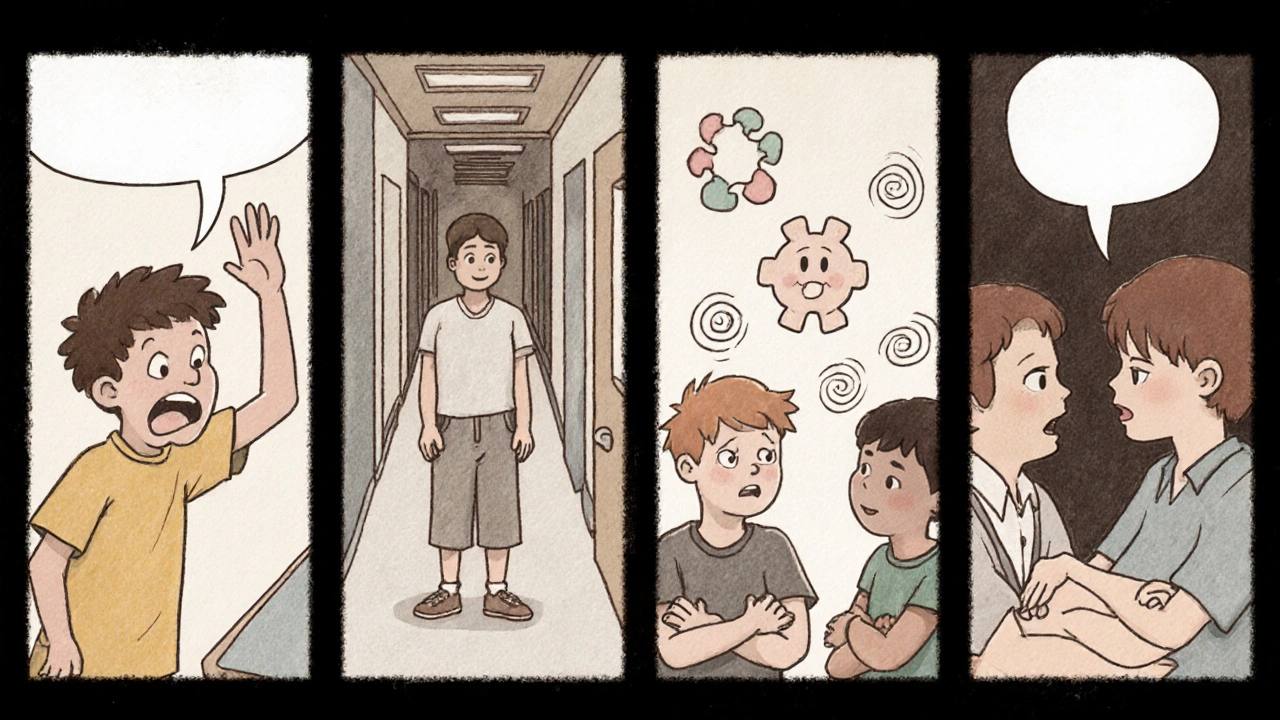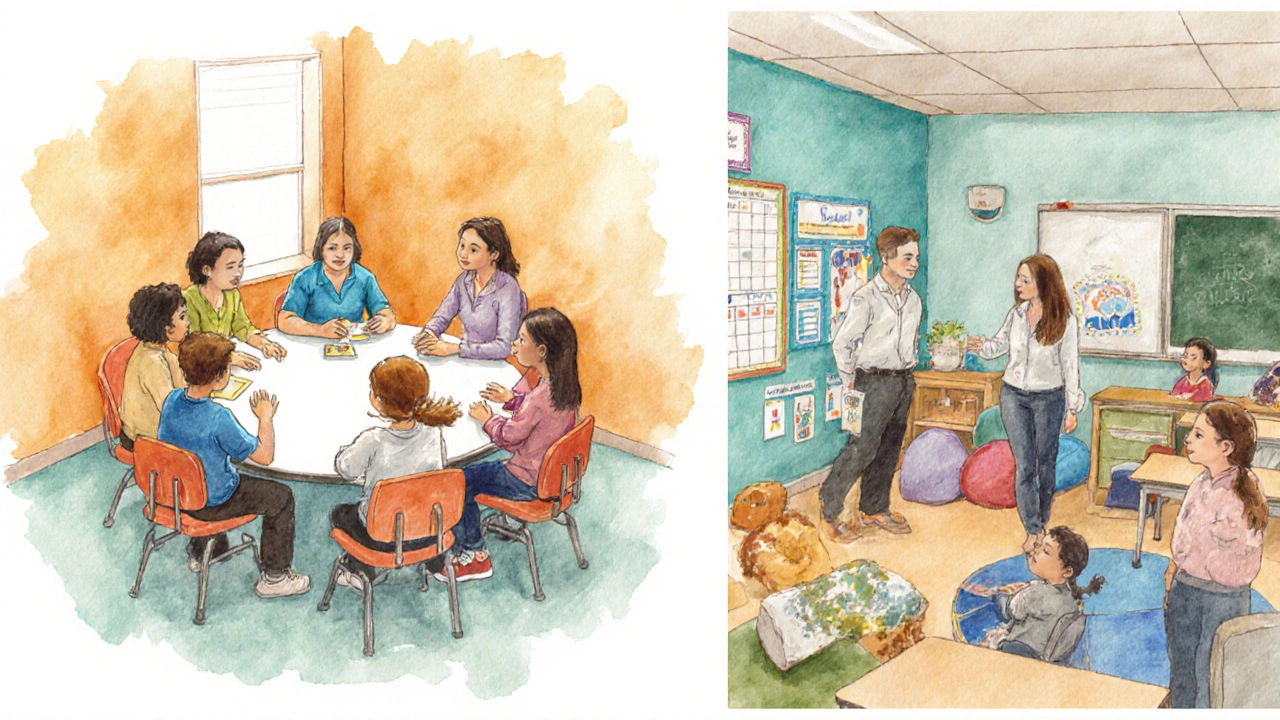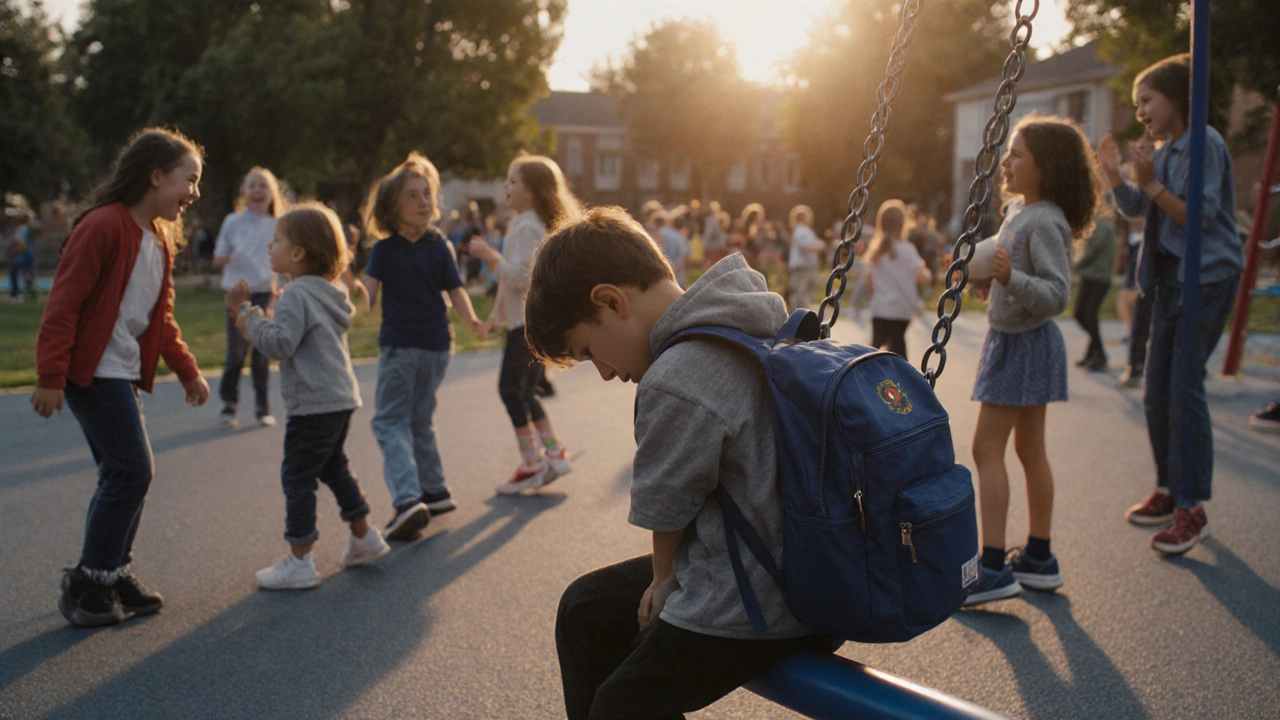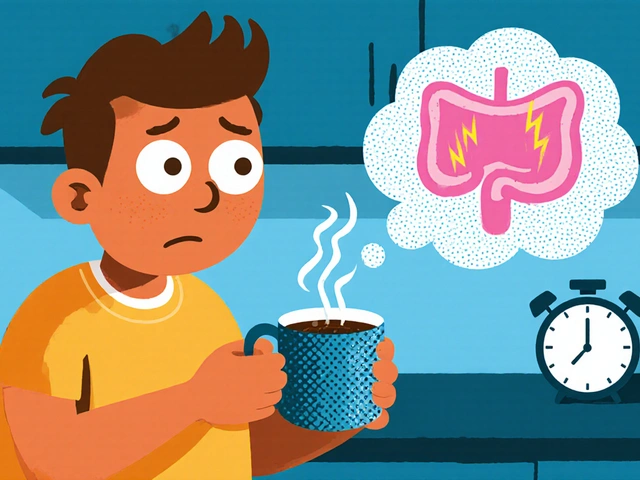How Behavior Disorders Affect Social Skills and Relationships
Social Skills Assessment Tool
How This Tool Works
Identify specific social challenges related to behavior disorders and get targeted recommendations for improvement. This tool will help you understand what skills need development and what interventions are most effective for your situation.
Select all challenges you observe
Ever wondered why a child with a diagnosed condition seems to struggle making friends or keeping a steady relationship? The answer often lies in the ways behavior disorders shape the way we interact, read cues, and manage emotions. This article breaks down the chain reaction from the disorder itself to everyday social life, and gives practical steps for parents, teachers, and anyone who wants to support smoother connections.
Key Takeaways
- Behavior disorders alter brain pathways that control impulse control, attention, and emotional regulation, directly influencing social behavior.
- Common disorders such as ADHD, Autism Spectrum Disorder (ASD), Conduct Disorder, and Oppositional Defiant Disorder have distinct patterns of social difficulty.
- Impaired social skills affect friendships, family dynamics, and romantic relationships, often creating a cycle of isolation.
- Early intervention-behavioral therapy, skills training, and supportive environments-can dramatically improve outcomes.
- A simple checklist helps caregivers monitor progress and adjust strategies.
What Is a Behavior Disorder?
Behavior disorder is a mental health condition characterized by persistent patterns of disruptive, impulsive, or socially inappropriate actions that deviate from cultural norms and cause functional impairment. These disorders often emerge in childhood and can continue into adulthood if untreated. They differ from mood or anxiety disorders by focusing on the regulation of behavior rather than internal emotional states, though overlap is common.
Key attributes include:
- Difficulty with impulse control
- Challenges in attention and executive functioning
- Frequent conflicts with authority figures
- Reduced empathy or misreading of social cues
Social Skills: The Building Blocks of Relationships
Social skills are the set of abilities that enable individuals to communicate, cooperate, and form connections with others. They include verbal and non‑verbal communication, perspective‑taking, conflict resolution, and the ability to read facial expressions and tone. When these skills are underdeveloped, everyday interactions can feel like a maze.
Because behavior disorders often disrupt the very processes that support skill acquisition-such as sustained attention and emotional regulation-the gap between “knowing how to act” and “actually acting” widens.

How Specific Disorders Shape Social Interaction
Attention‑Deficit/Hyperactivity Disorder (ADHD)
Attention‑Deficit/Hyperactivity Disorder (ADHD) affects roughly 9% of school‑age children worldwide. Its core symptoms-hyperactivity, impulsivity, and inattention-interfere with listening, turn‑taking, and staying on topic.
Typical social challenges:
- Interrupting peers during conversation
- Missing social cues due to distractibility
- Frequent “forgotten” commitments that erode trust
Research from the Journal of Child Psychology (2023) shows that children with ADHD are 2.5 times more likely to be rejected by classmates and experience lower quality friendships.
Autism Spectrum Disorder (ASD)
Autism Spectrum Disorder is a neurodevelopmental condition present in about 1 in 44 children in the United States. While ASD is not classified as a behavior disorder per se, many individuals display comorbid behavioral challenges that impact social functioning.
Key social differences include:
- Difficulty interpreting non‑verbal signals such as eye contact and facial expression
- Preference for routine, leading to discomfort with spontaneous social activities
- Literal interpretation of language, causing misunderstandings
Data from the CDC (2024) indicates that 70% of high‑functioning autistic teens report feeling “lonely” despite being surrounded by peers.
Conduct Disorder (CD)
Conduct Disorder involves a pattern of violating the rights of others, aggression, and serious rule‑breaking. It is diagnosed in about 3-5% of adolescents.
Social repercussions are often severe:
- Peer exclusion due to aggression or bullying behavior
- Legal problems that strain family relationships
- High risk of transitioning to antisocial personality disorder in adulthood
Longitudinal studies (e.g., Moffitt et al., 2022) reveal that early intervention reduces the likelihood of adult criminality by up to 30%.
Oppositional Defiant Disorder (ODD)
Oppositional Defiant Disorder is marked by a persistent pattern of angry/irritable mood, argumentative behavior, and vindictiveness. It affects roughly 2-3% of children.
Social effects include:
- Frequent arguments with teachers and parents, leading to strained authority relationships
- Difficulty maintaining friendships due to perceived hostility
- Elevated stress levels in family settings, sometimes triggering parental burnout
Relationship Fallout: From Family to Romance
When social skills are compromised, the ripple extends beyond the classroom.
Family Dynamics
Parents may experience constant power struggles, especially with ODD and CD. Siblings can feel neglected or become scapegoats, increasing the risk of sibling rivalry violence.
Friendships
Peers often rely on subtle signals-shared jokes, quick back‑and‑forth banter-to bond. Children with ADHD or ASD may miss these cues, leading to misinterpretations and eventual withdrawal.
Romantic Relationships
Adults with unresolved behavior‑related social deficits report higher rates of breakup, marital conflict, and lower satisfaction. A 2022 study in the Journal of Adult Development found that adults with a history of CD had a 40% lower marriage stability rate compared to the general population.
Intervention Strategies That Work
While the challenges are real, targeted approaches can rebuild social competence.
Cognitive Behavioral Therapy (CBT)
Cognitive Behavioral Therapy (CBT) helps individuals identify distorted thought patterns and replace them with healthier behaviors. For ADHD, CBT improves self‑monitoring; for ODD, it reduces oppositional attitudes.
Social Skills Training (SST)
Structured groups teach role‑playing, perspective‑taking, and conflict resolution. Evidence from a 2021 meta‑analysis shows SST leads to a 25% increase in peer acceptance scores.
Parent Management Training (PMT)
Equips caregivers with consistent reinforcement techniques, reducing power struggles and modeling appropriate social behavior.
School‑Based Supports
Adjustments such as “quiet corners” for overstimulation, visual schedules for routine, and peer‑buddy systems boost inclusion. Collaboration between teachers, counselors, and families is essential.

Quick Checklist for Parents and Educators
- Identify the specific behavior disorder and its core symptoms.
- Observe the child’s social interactions in multiple settings (home, school, community).
- Map recurring challenges (e.g., interrupting, missing cues, aggression).
- Choose evidence‑based interventions (CBT, SST, PMT) that target identified gaps.
- Set measurable goals (e.g., “maintain eye contact for 5 seconds in 3 out of 5 conversations”).
- Track progress weekly and adjust strategies as needed.
- Celebrate small victories to reinforce motivation.
- Seek professional consultation if behavior escalates or interferes with academics.
Comparison of Common Behavior Disorders and Their Social Impact
| Disorder | Core Symptoms | Typical Social Difficulties | Most Effective Intervention |
|---|---|---|---|
| ADHD | Inattention, hyperactivity, impulsivity | Interrupting, missing cues, unreliable commitments | CBT + Social Skills Training |
| Autism Spectrum Disorder | Restricted interests, sensory sensitivities, social communication deficits | Misreading facial expressions, literal language, routine reliance | Structured Social Skills Groups + Visual Supports |
| Conduct Disorder | Aggression, property destruction, deceit | Peer rejection, legal trouble, family conflict | Multimodal therapy (CBT + Family Therapy) |
| Oppositional Defiant Disorder | Argumentativeness, hostility, vindictiveness | Authority clashes, friendship strain, parental burnout | Parent Management Training + CBT |
Looking Ahead: Building Resilient Social Networks
Successful social integration isn’t just about “fixing” a disorder; it’s about cultivating environments where diverse communication styles are accepted. Schools that embed inclusive curricula, workplaces that offer mentorship programs, and families that practice empathy can transform the trajectory for individuals with behavior disorders.
By understanding the direct link between the disorder and social outcomes, stakeholders can intervene early, tailor support, and ultimately improve relationship quality across the lifespan.
Frequently Asked Questions
Can behavior disorders be outgrown?
Many symptoms lessen with age, especially with early intervention. However, underlying neuro‑developmental traits often persist, so ongoing support remains valuable.
How do I know if my child’s social struggles are due to a behavior disorder?
Look for a consistent pattern across settings (home, school, community) that interferes with daily functioning, and consider a professional evaluation if concerns last longer than six months.
Are medications helpful for improving social skills?
Medication can reduce core symptoms (e.g., impulsivity in ADHD) which creates space for skill training, but it doesn’t replace direct social skills instruction.
What role do peers play in the treatment process?
Positive peer interaction reinforces learned behaviors; structured peer‑buddy programs often lead to quicker gains in confidence and acceptance.
How can adults with a history of behavior disorders improve their romantic relationships?
Couples counseling that incorporates CBT techniques, open communication training, and, when needed, medication management can address lingering impulsivity or emotional regulation issues.






10 Comments
Greg McKinney
October 14 2025Honestly, this piece reads like a textbook summary that pretends to be groundbreaking. Most of the stuff about ADHD and ASD is already common knowledge among teachers.
emma but call me ulfi
October 21 2025I see where you're coming from, but the practical checklist at the end does help parents who aren't specialists. It's nice to have clear steps laid out.
George Gritzalas
October 28 2025Wow, another endless list of bullet points and jargon-who needs that? The author could have saved us a thousand words by just saying “listen and don’t be rude.” Also, anyone notice the inconsistent use of “behavior” vs “behaviour” throughout?
Alyssa Matarum
November 4 2025Spot on about the commas, George. I’d add that the content itself is solid, just the presentation could be tighter.
Mary Akerstrom
November 11 2025Behavior disorders shape how we interact with the world.
They affect impulse control and attention.
Those changes ripple into everyday conversation.
Missing a cue can feel like a social landmine.
Kids with ADHD often interrupt and then wonder why friends are annoyed.
Autistic teens may read a smile as a neutral expression.
Conduct disorder leads to aggression that pushes peers away.
Oppositional defiant kids argue and end up isolated.
All these patterns make friendships fragile.
Families feel the strain as conflicts rise.
Schools see higher referral rates for social skill deficits.
Early interventions can rewrite those trajectories.
CBT teaches self‑monitoring and perspective taking.
Social skills groups give practice in a safe setting.
When we combine therapy with supportive environments the outcomes improve dramatically.
Delilah Allen
November 18 2025While your optimism is commendable, let's not ignore the systemic failures that leave these kids unsupported. The article glosses over the fact that many schools lack funding for proper interventions. Moreover, treating behavior disorders as simply a set of skills to be taught ignores the deeper neurobiological realities. We need a societal shift, not just a checklist.
Nancy Lee Bush
November 25 2025Great summary! 😊 I love how you highlighted both the challenges and the hopeful strategies. It really shows that with the right tools, anyone can improve their social game.
Dan Worona
November 25 2025What if the whole “intervention” industry is just a profit machine?
Chuck Bradshaw
December 2 2025In my experience, the success rates of CBT and SST vary wildly depending on the therapist's competence. I've seen cases where a poorly trained facilitator actually worsened the child's anxiety. It's crucial to verify credentials and demand evidence‑based protocols. Also, medication should not be dismissed outright; for many ADHD patients, stimulants lay the groundwork for effective skill training.
Howard Mcintosh
December 9 2025yeah u r right chuck lol but sometimes ppl just need a nudge not a whole psych eval.